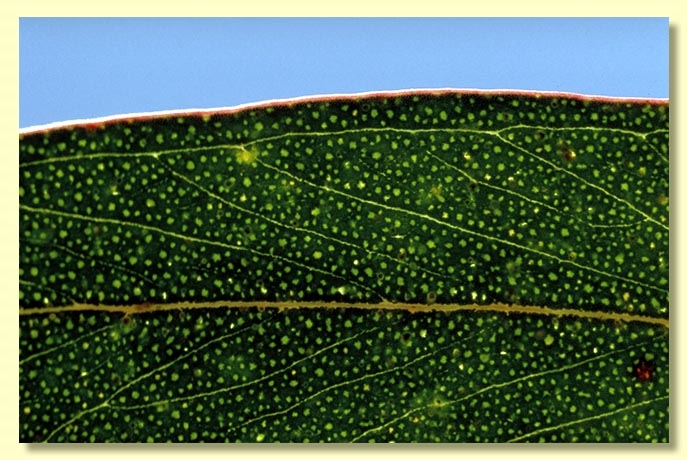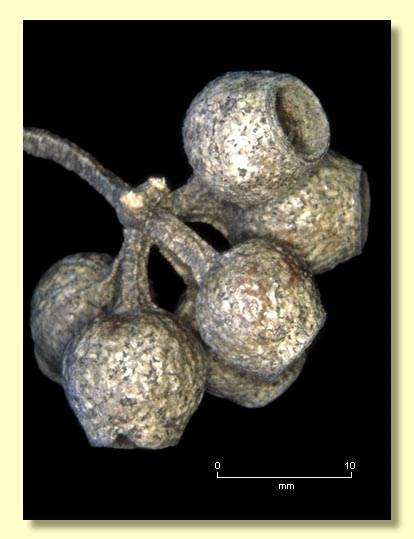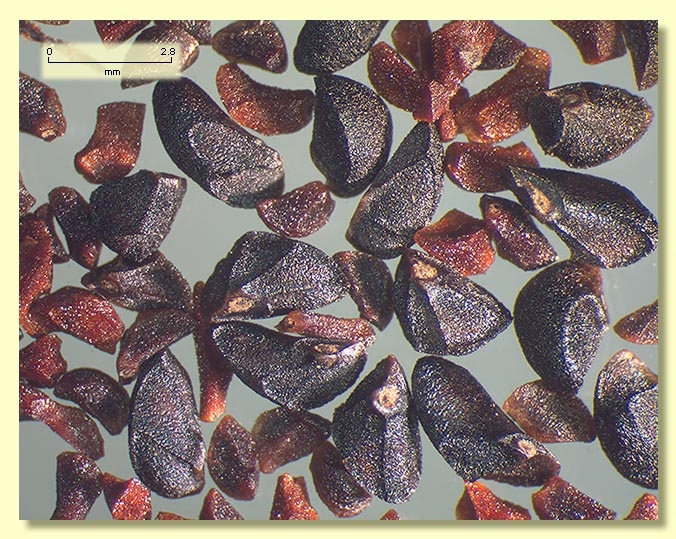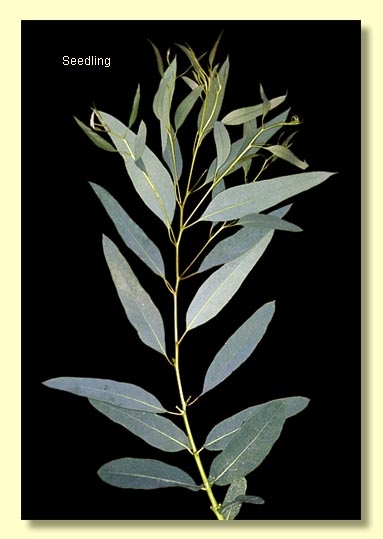Euclid - Online edition
Eucalyptus fraxinoides
Eucalyptus | Eucalyptus | Cineraceae | Fraxinales
E. virgata var. fraxinoides (H.Deane & Maiden) Maiden, Forest Fl. New South Wales 3: 87 (1907). T: Tantawangalo Mtn [near Cathcart], NSW, Dec. 1896, H.Deane s.n.; lectotype: NSW [NSW26878]; fide Bean, A.R., Telopea 12(4): 516 (2010).
Bark rough on basal 4–5 m of trunk, compacted, grey, grey-brown or black; smooth bark white, cream or pale grey, with scribbles, occasionally with horizontal black scars, often ribbony, branchlets sometimes glaucous.
Juvenile growth (coppice or field seedlings to 50 cm): stem square or rounded in cross-section, occasionally glaucous; juvenile leaves opposite, sessile, elliptic and amplexicaul for first 5 or 6 nodes, then petiolate, alternate, ovate to lanceolate to falcate, 6–15 cm long, 1.5–4.5 cm wide, green to blue-green.
Adult leaves alternate, petiole 0.8–1.6 cm long; blade lanceolate to falcate, 8–18 cm long, 1–3.5 cm wide, base oblique or tapering to petiole, concolorous, glossy, green, side-veins acute, reticulation absent, intramarginal vein parallel to and remote from margin, oil glands mostly island.
Inflorescence axillary unbranched, peduncles 0.5–1.8 cm long, buds 7, 9 or 11 per umbel, pedicels 0.1–0.6 cm long. Mature buds obovoid to ovoid, 0.5–0.6 cm long, 0.3–0.4 cm wide, usually green, or red, sometimes slightly warty, scar absent, operculum conical to rounded to apiculate, stamens inflexed or irregularly flexed, anthers reniform to cordate, versatile, dorsifixed, dehiscing by confluent slits, style long, stigma tapered, locules 4 or 5 each with 2 vertical ovule rows. Flowers white.
Fruit pedicellate (pedicels 0.1–0.6 cm long), barrel-shaped, urceolate or truncate-globose, 0.6–1 cm long, 0.6–1.1 cm wide, disc descending, valves 4 or 5, enclosed.
Seeds black, 1.5–3.5 mm long, pyramidal or obliquely pyramidal, dorsal surface smooth, or shallowly pitted, hilum terminal.
Cultivated seedlings (measured at ca node 10): cotyledons reniform; stems rounded or square in cross-section; leaves initially opposite, sessile, elliptic with rounded apex, amplexicaul base and discolorous to node ca 5 or 6, then petiolate, alternate, elliptic-lanceolate, 7–13 cm long, 2–4 cm wide, base now tapering, apex pointed, bluish green to green.
Flowering has been recorded in January and February.
A medium-sized to tall tree of mountains in south-eastern New South Wales, and lower hills of the Howe Range in far eastern Victoria.
E. fraxinoides is a blue-leaved ash (referring to the colour of the juvenile leaves) and is distinguished by the black butt of compact rough bark with a smooth white trunk above, usually densely covered with scribbles, glossy green adult leaves, strongly urceolate fruit, and black seeds. It differs from the other similar-looking species in the area, E. stenostoma, by the seven- to eleven-budded inflorescences (>11 in E. stenostoma), erect buds (pendulous in E. stenostoma), and urceolate fruit. Other ashes in the general area of occurrence are thr green-leaved ash species E. dendromorpha, E. triflora and E. paliformis, the last named being the only one to co-occur in the Wadbilliga area north-east of Cooma. All three are brown-seeded ash species and therefore not closely related. E. triflora can be further distinguished by usually having three-budded inflorescences.
Eucalyptus fraxinoides belongs in subgenus Eucalyptus section Cineraceae series Fraxinales having the following characters: cotyledons reniform, juvenile leaves alternate, bluish green, adult leaves with acute side-veins, single axillary inflorescences with buds in clusters of seven to 15, buds with single operculum, irregularly flexed stamens with reniform anthers, ovules in two rows, and seeds ± pyramidal.
The closest relatives of E. fraxinoides are E. delegatensis, which differs in finely fibrous rough bark on the trunk and brown seed, and the more northerly E. oreades with its short stocking of rough bark shedding in very coarse ribbons. A third related species, E. luehmanniana, is a smooth-barked mallee of coastal sandstone areas, with conspicuous quadrangular branchlets and dark brownish seed. Together these four species make up series Fraxinales.












